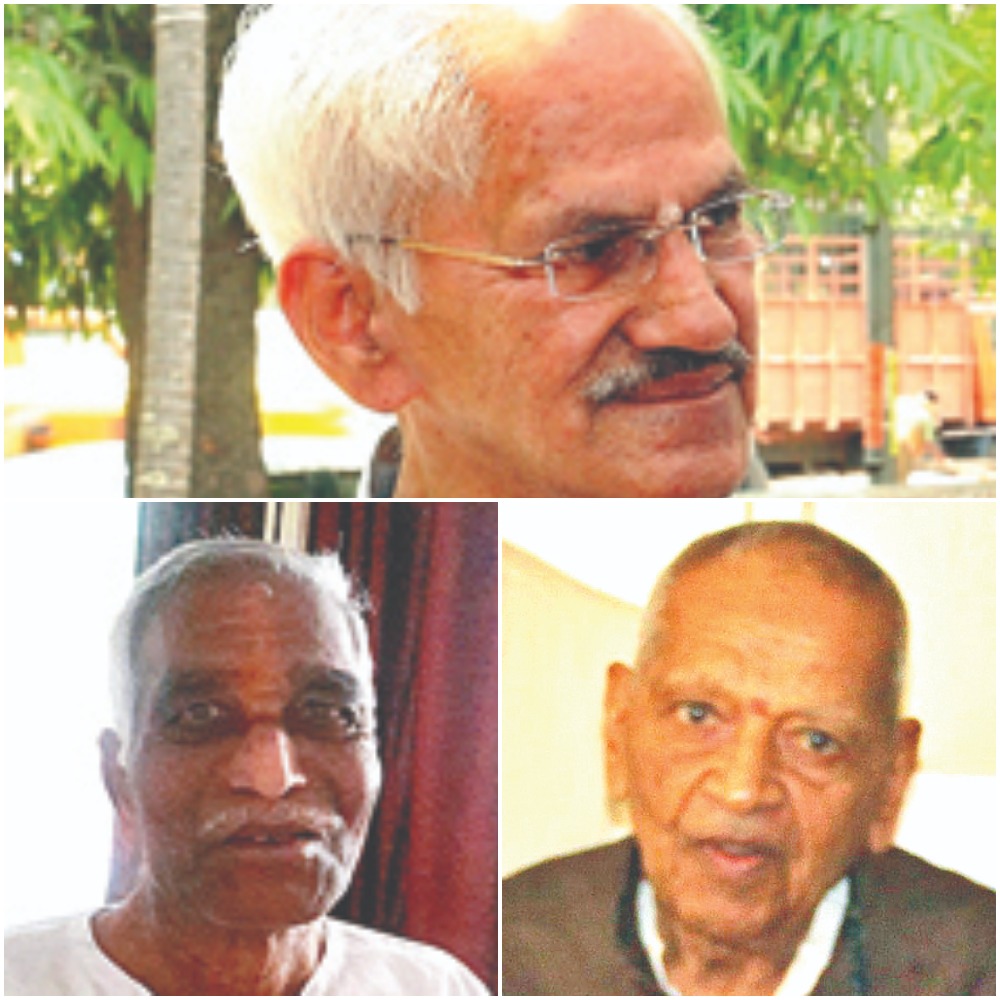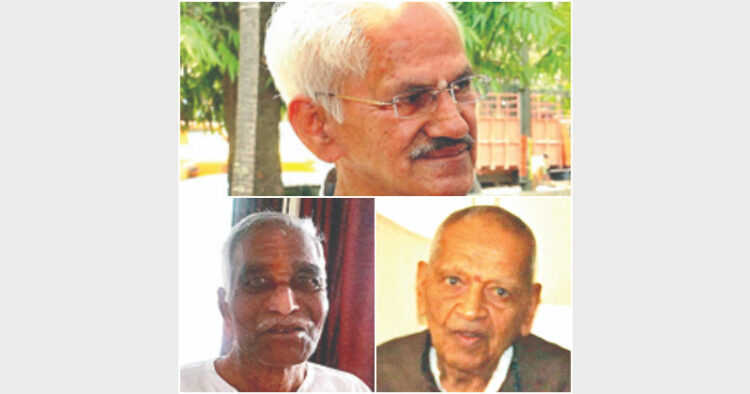The tumultuous times of the Emergency was also the period which showcased the determination of Rashtriya Swayamsewak Sangh (RSS) to fight the hegemony of Indira Gandhi and its tenacity to involve common people to work for the nation. Karnataka was no exception to this. RSS leaders in the State had planned a multi-pronged approach to tackle the Emergency. While many swayamsevaks worked clandestinely to ensure that any communication and news reaches intended people on time, many took on the government overtly in the form of Satyagraha. Satyagraha involved peaceful protests and demonstrations by hundreds of Karyakartas in front of government offices and police stations. They were brutally beaten and arrested. Organiser talked to a few senior RSS Pracharaks who reminisced the days of Emergency and their participation in the Satyagraha.

“Not one incident of violence during Satyagraha”— Shri Chandrashekar Bhandari, Senior Pracharak
“The role of students in the Satyagraha was paramount. In Mangaluru vibhag, students from many colleges rose in unison and protested against the Emergency. I remember Krishnappa ji used to say that the power of the youth has to be harnessed to work for the nation provided that they are given the required ideological education. The JP Movement had succeeded only because the youth were involved in large numbers. Our experiment to involve youngsters in satyagraha was hugely successful as the maximum number of students in the country to have participated in the satyagraha were in Mangaluru. Just in a small town called Ujire, near Dharmasthala, more than 1000 students had assembled and then took part in the Satyagraha. The role of teachers and lecturers of the college was also important as it was they who educated the students and provided the ideological foundation. We should not forget one most important aspect of our Satyagraha during the Emergency. Lakhs of students participated in the Satyagraha all over the state. There were thousands of protests by the students. As we all know, the youth force when, it comes together, is highly inflammable. But throughout the Satyagraha there was not even one incident of violence or arson by the students. The reason was that the student force was led by Sangh Swayamsevaks. At several places, the police had lathicharged the students but the students did not resort to violence. I remember that at many places, including in Tumkur where I was the Karyavaha, seeing the police brutality on the young students, the public came together on their own and protested against the police. The police were forced to retreat.
Even girls were part of the Satyagraha. The students used to assemble and then give a memorandum to the Tahsildar in their locality. The non-violence of the Satyagraha was the main factor behind the popular support of the common people which led to its success.”
“Police committed untold atrocities on Satyagrahis”— Shri Ka Shri Nagaraj, Senior Pracharak
“I remember that I was part of the Satyagraha that was organised in Bengaluru, a few days after emergency was declared. Atal Ji, Advani Ji and many others were present at the city townhall on June 24, 1975. Even Deve Gowda was present and participated in that Satyagraha. While several underground tasks were being executed by us, RSS also arranged the meeting with George Fernandes.
On November 14, 1975 Satyagraha was organised at several places in the State. Hundreds of Swayamsevaks were arrested and jailed under MISA. The police atrocities on them were inhuman. BV Shesha, Swayamsevak was arrested for participating in the Satyagraha and given third degree torture. Even his driver was arrested and also tortured. Arakali Narayan Ji and HV Sheshadri Ji were instrumental in organising underground activities related to publishing. The police could not trace them for long. Arakali Narayan was arrested later and housed in the Bellary jail. HV Sheshadri ji escaped the eyes of the police and toured all 4 southern states of Andhra Pradesh, Tamil Nadu, Kerala and Karnataka without being detected. He was also entrusted with the task of publications in these states.
Details of Satyagraha and other activities have been mentioned in detail in the Kannada book ‘Bhugilu’ which chronicles the incidents right before the declaration of Emergency, the role of RSS during the period, legal battles and events thereafter.”
Bhugilu meaning flame, was first published in 1977 by Rashtrotthana Sahitya few months after the emergency was lifted. It is a chronicle of the nationwide struggle of the Indians against the tyrannical rule of Indira Gandhi led Congress Government between 1975-77. Shri HV Sheshadri was a Chief Editor of the book. It records the experiences of the swayamsevaks, pracharaks, leaders among the soulful narration of events. It also chronicles the atrocities committed on people in Karnataka and the torments faced by those fighting for democracy. Violence by the state, role of the opposition, subservience of the Communists, protests by the people across the state and country, have all been recorded in this 635 page work. Many contemporary literary figures have opined that ‘Bhugilu’ stands as the greatest book on Emergency in Kannada. Senior Pracharak Ka Shri Nagaraj was part of the editorial team of this book.
Ganapathi appears out of thin air in Mangaluru! — Shri Chandrashekar Bhandari
It was August 1975. As every year, Ganapathi utsav had to be celebrated in Sanghaniketan, RSS Karyalaya in Mangaluru. But with the declaration of Emergency, Sangh was banned and all Sangh Karyalayas were under round-the-clock surveillance. No activities were allowed inside the premises. Krishanappa Ji opined that the Ganapathi Utsav at Sanghaniketan had to happen due to 3 reasons. 1) Give a message to the government that the draconian emergency will not be accepted lying down 2) It would boost the moral of the swayamsevaks who were tormented by the police and the government 3) Common public had lot of devotion towards Ganapathi. Conducting the popular utsav will give the public support to the Sangh.
Hence it was decided that the Ganapathi Utsav will be conducted come what may. The way it was planned and executed is thrilling.
There are many houses adjacent to Sanghaniketan. The Ganapathi idol with all decorations and required pooja items was kept ready just next to a compound in an adjacent house. Swayamsevaks then managed to switch off the power at the local sub-station. It was dark all over the area. The police were clueless. In the dark, Ganapathi idol was transferred inside the Karyalaya compound and everything was kept ready. The power was switched on and voila! Ganapathi appeared out of thin air inside the premises of Sanghaniketan. The police were flabbergasted when they noticed it. They could not risk angering the people by removing it. Moreover, Ganapathi utsav was not prohibited and no action could be taken legally. When people started arriving, the police decided to remain mute spectators. Ganapathi Utsav went on with all gaiety.
The Ganapathi incident during the Emergency showcases how the determination of Swayamsevaks can achieve anything without any confrontation or violence.
Underground Foot Soldiers – The Pillars of Emergency Fightback— Shri Ramananda Achar, Senior Sub-Editor Vikrama Kannada Weekly
“When Be.Su.Na Mallya, then editor of Vikrama, was first arrested by the police under MISA, I ran to Keshav Krupa to convey the information. From then on, passing on information and posting required newspapers and pamphlets became my tasks during the emergency period. Vikrama Printing press was seized. There were no other outlets to carry Sangh news.
As per the directions of then Mahanagar Sanghachalak Shri M Narasihmachar, I along with few others started to prepare hand written news in about 2 pages. Made carbon copies of them and then distributed it to other vibhags. Everything was done clandestinely. We used other names like Kahale, Jyoti for our newspapers which had to be printed.
I also used to post the newspapers which were printed under pseudonyms. But had to strategically post them as all posts together would rise suspicions. I posted a few in one post box and the next few in another post box on the next street. Even booklets which we printed in English were posted in this manner.
Without passing information and exchanging news, there were no other outlets to convey Sangh’s views. Towards the end of Emergency Vikrama started publishing again in a different press which belonged to a well-wisher. During the entire emergency period, our daily food was uncertain. We used to have our food in a different house almost each day and stayed in schools.”














Comments